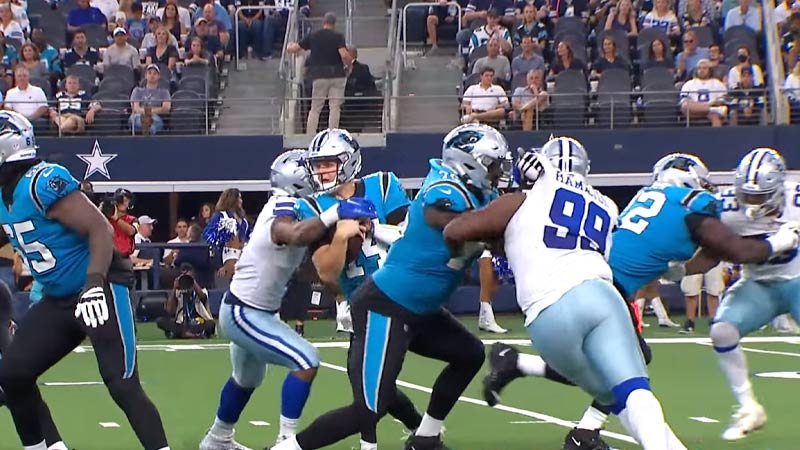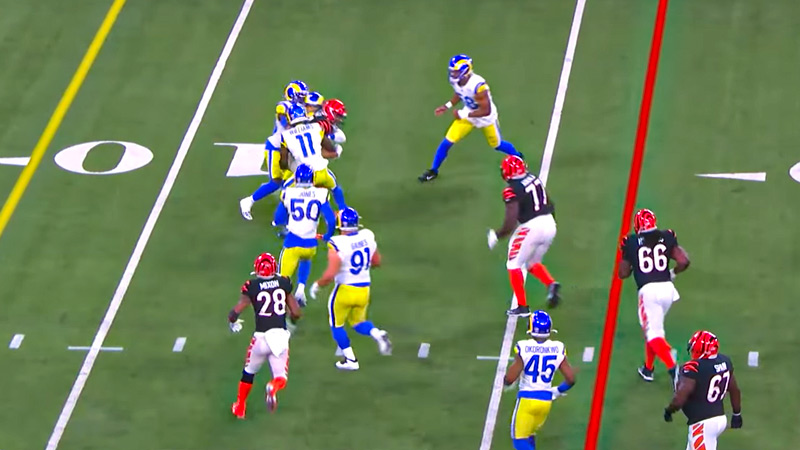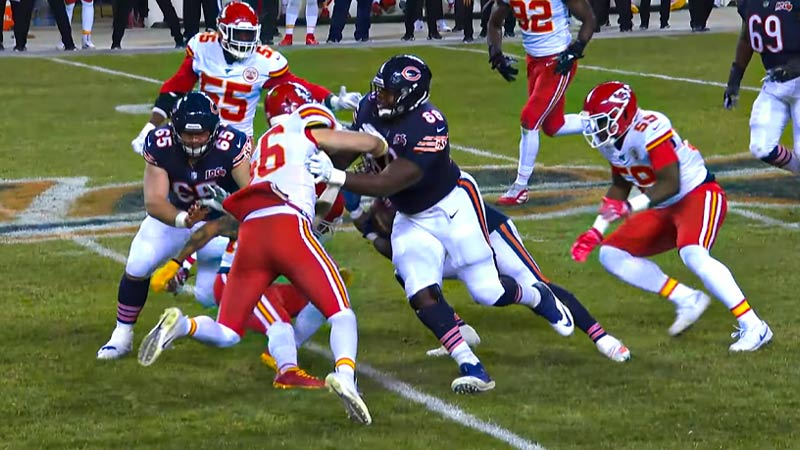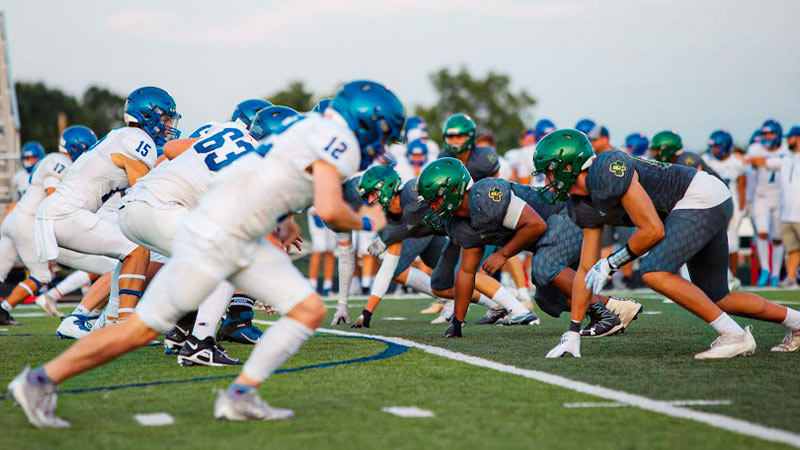In the intricate world of football tactics, there are strategies that can shift the balance of a game and turn the tide in favor of the defending team. One such potent strategy is the “Overloaded Defense.”
This approach involves strategically positioning more defenders in specific areas of the field to create a numerical advantage, stifle the opponent’s attacking prowess, and regain control of the game.
In this blog post, we delve into the intricacies of an overloaded defense in football, exploring its nuances, applications, and the impact it can have on the beautiful game. So, stay focused.
What Is Overloaded Football?
Overloaded football, also known as overload play or tactical overloading, is a strategy used in soccer (football) to create numerical advantages in specific areas of the field.
This tactic involves sending more players into a particular zone of the pitch to outnumber and overwhelm the opposition players in that area. The primary goal of overloading is to break through defensive lines, especially those that are well-organized and difficult to penetrate.
The concept of overloading revolves around the idea that by concentrating more players in a certain space, the attacking team can force the defending team to commit more players to that area in order to maintain their defensive shape.
This can create gaps or spaces in other areas of the field that the attacking team can exploit to create scoring opportunities. Overloading can be particularly effective against teams that employ a low-block defense or rely on maintaining a compact formation to frustrate opponents.
For example, if a team is facing a well-organized defense with two compact lines of players, they might use overloading by sending multiple players into a certain zone, thus attracting the attention of defenders and pulling them out of their positions.
This can create spaces for quick passes or dribbles to exploit the gaps left behind by the defenders who were drawn to the overloaded area.
What Is an Overloaded Defense in Football?

An overloaded defense in football refers to a defensive strategy where a team positions more defenders than there are attackers in a specific area of the pitch, typically in their defensive third.
This tactical approach is designed to create a numerical advantage for the defending team in order to stifle the attacking team’s progress and scoring opportunities.
The concept of an overloaded defense stems from the principle that having more defenders in a certain area increases the likelihood of thwarting the attacking team’s advances and regaining possession of the ball.
In the context of a football match, teams generally deploy more players in defensive roles than in offensive roles. As a result, there are often instances where the attacking team faces a numerical underload, meaning they have fewer players forward compared to the number of defenders they’re up against.
This scenario is particularly common in the defensive third of the field, where teams want a solid defensive structure to prevent conceding goals. To execute an overloaded defense, the defending team strategically positions its players to congest the areas where the attacking team is trying to create chances.
When to Use Overloaded Defense?

An overloaded defense can be an effective strategy in specific situations to disrupt the opposing team’s attacking efforts and regain control of the game.
Here are some scenarios in which using an overloaded defense can be advantageous:
Protecting a Lead
When your team is leading and wants to secure the advantage, an overloaded defense can help congest crucial areas of the field, making it difficult for the opposing team to create clear-cut scoring opportunities. This is often seen in the latter stages of a match when the leading team aims to maintain their advantage.
Against Strong Offensive Teams
Using an overloaded defense can be a smart approach when facing opponents known for their potent attacking play. By crowding areas where their creative players tend to operate, you can limit their space and options, making it harder for them to penetrate your defense.
Defending Set Pieces
Overloading the penalty area during defensive set pieces (such as corners and free kicks) can help prevent the opposing team from getting clean headers or shots on goal. By placing more defenders in these critical areas, you enhance your chances of clearing the ball and minimizing the threat.
When Numerical Superiority Matters
Situations where you’re facing an opponent with a numerical advantage, such as a counterattack, can be mitigated by deploying an overloaded defense. By quickly positioning more defenders back, you can regain a numerical balance and neutralize the opponent’s attacking opportunity.
In High-Pressure Situations
Overloading your defensive third in high-pressure moments can help prevent the opposition from finding gaps and exploiting defensive vulnerabilities. This approach can be particularly effective against opponents who are pressing aggressively to win the ball back.
Against Skilled Playmakers
When facing teams with skillful playmakers who thrive on open space, using an overloaded defense can limit their options and force them into making rushed decisions. By crowding their preferred areas, you disrupt their rhythm and creativity.
Managing Game Tempo
Employing an overloaded defense can also be a way to dictate the pace of the game. By slowing down the opposition’s attacks and frustrating their efforts to build up play, you can control the flow of the match.
Neutralizing Wide Attacks
Overloading your defensive flanks can be useful when your opponent relies heavily on wide attacks and crossing. By packing the wings, you can reduce the space available for crosses and make it challenging for them to deliver quality balls into the box.
It’s important to note that while an overloaded defense can be effective, it should be used strategically and judiciously. Overloading in one area might leave other parts of the field vulnerable, and using this strategy throughout the entire game could lead to fatigue and decreased effectiveness.
Strategies of Overloaded Defense in Football

Implementing an overloaded defense in football involves strategic positioning, coordination, and understanding of the game situation. Here are some key strategies to effectively execute an overloaded defense:
Zone Congestion
Identify the areas of the field where the opposing team tends to create chances or where their key playmakers operate. Position your defenders to congest those zones, making it difficult for the attackers to find space and pass lanes.
Numerical Superiority
Ensure that you have more defenders than attackers in the targeted area. This numerical advantage makes it challenging for the opposing team to progress and forces them into making hasty decisions.
Pressing and Closing Down
Apply high-intensity pressing in the overloaded areas. This prevents the attackers from having time to think and forces them into errors or hurried passes, increasing the chances of regaining possession.
Communication and Coordination
Effective communication among defenders is crucial. Players should be constantly aware of their positions, their teammates’ positions, and the movement of the opposing attackers. Clear communication helps maintain the integrity of the overloaded defense.
Anticipate Passes and Movements
Study the patterns of the opposing team’s attacks. Anticipate their passes and movements to position defenders strategically. This allows you to intercept passes or engage attackers before they receive the ball.
Quick Transitions
While focusing on defending, be prepared for quick transitions to offense. As soon as possession is regained, look to exploit the gaps left by the opposing team’s rush to the overloaded area.
Use of Sweeper or Libero
Having a sweeper or libero player who can read the game well and cover spaces left behind by the overloaded defense can provide additional security against counterattacks.
Forcing Wide Play
If your overloaded defense forces the opponent to play wide, make sure to quickly shift your defensive focus to the flanks. This prevents them from finding space on the wings and limits their crossing opportunities.
Blocking Passing Lanes
Position defenders to block passing lanes and cut off options for the attackers. This forces the opposing team into making riskier or less effective passes.
Stay Disciplined
While it’s important to press and close down the opposition, defenders should also maintain their positional discipline. Rushing out of position can create gaps that skilled attackers can exploit.
Balanced Overloading
Avoid overloading in one area to the extent that it leaves other parts of the field vulnerable. Maintain a balanced defensive structure to prevent opponents from simply exploiting the underloaded areas.
Flexibility
Be adaptable in your approach. If the opposition adjusts to your overloaded defense, be prepared to switch strategies and adapt to their changes.
Use of Counter-Pressing
If the ball is lost while executing an overloaded defense, immediately engage in counter-pressing to win the ball back before the opponents can exploit any spaces left open.
Conditional Timing
Employ overloaded defense strategically based on the match situation, scoreline, and the opponent’s strengths. There might be moments when pressing higher or maintaining a regular defensive shape is more appropriate.
FAQs
What exactly is an overloaded defense in football?
An overloaded defense refers to a tactical strategy where a team positions more defenders than there are attackers in a particular area of the field. This creates a numerical advantage for the defending team, making it challenging for the opposing attackers to progress and create goal-scoring opportunities.
When is an overloaded defense commonly used?
Teams often use an overloaded defense to protect a lead, thwart strong offensive teams, defend against set pieces, neutralize skilled playmakers, and manage high-pressure situations. It’s a strategic approach aimed at disrupting the flow of the opponent’s attacks and gaining control of the match.
How does an overloaded defense impact the flow of the game?
An overloaded defense can congest key areas of the field, limiting the space available for attackers to maneuver. This forces the opposition into rushed decisions, increases defensive pressure, and can lead to turnovers or disrupted attacking patterns.
What are the key elements of executing an overloaded defense effectively?
To execute an overloaded defense successfully, proper communication among defenders, anticipation of opposition movements, effective pressing, and maintaining positional discipline are crucial. Flexibility and adaptability based on the match situation also play a significant role.
What are the potential risks of using an overloaded defense?
While an overloaded defense can be effective, it requires a fine balance. Overloading in one area could expose vulnerabilities in other parts of the field, potentially leading to counterattacks or exploitation of underloaded areas by the opposition.
Wrapping Up
In the dynamic world of football, tactical innovations continuously shape the outcomes of matches. The concept of an overloaded defense stands as a testament to the strategic depth of the game.
By understanding when and how to effectively deploy this tactic, teams can gain a tactical advantage, disrupt their opponents’ plans, and demonstrate the art of controlled defending.
Whether protecting a lead, countering a skilled playmaker, or neutralizing potent attacks, an overloaded defense is a testament to the fact that football is not only about scoring goals but also about orchestrating a symphony of strategies on the pitch. Best wishes.







